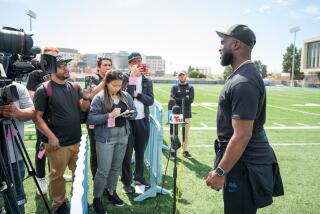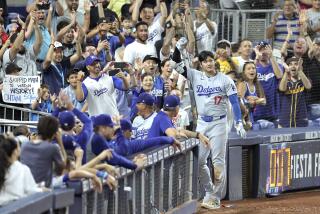Dodgers tap into âV energyâ
Reporting from Boston â The most curious figure to emerge in the Dodgersâ drama answers the door with a kindly smile and a hearty handshake. He motions toward the living room, where his wife has put out a spread of chocolate and fruit, coffee and tea.
Vladimir Shpunt, 71, lived most of his life in Russia. He has three degrees in physics and a letter of reference from a Nobel Prize winner.
He knows next to nothing about baseball.
Yet the Dodgers hired him to, well, think blue.
Frank and Jamie McCourt paid him to help the team win by sending positive energy over great distances.
Shpunt says he is a scientist and a healer, not a magician. His method could not guarantee the Dodgers would win, he says, but it could make a difference.
âMaybe it is just a little,â he said. âMaybe it can help.â
In the five years he worked for the Dodgers, he attended just one game. Instead, he watched them on television in his home more than 3,000 miles from Dodger Stadium, channeling his thoughts toward the teamâs success.
Shpuntâs work was one of the best-kept secrets of the McCourt era. The couple kept it hidden even from the teamâs top executives. But from e-mails and interviews, a picture emerges of how the emigre physicist tried to use his long-distance energy to give the Dodgers an edge.
The McCourts, who are embroiled in a contentious divorce, declined to be interviewed about Shpunt. Through their representatives, Frank said it was Jamieâs idea to hire him and Jamie said it was Frankâs.
Shpunt lives in suburban Boston, in a community he insisted not be named. He sits uneasily for an interview, joined by his wife Sofya and Barry Cohen, an executive leadership consultant who worked with the McCourts and who introduced Shpunt to Jamie.
Shpunt is wary of publicity, disappointed in the loss of his anonymity, concerned about being caricatured. He speaks reluctantly, in halting English, about a commitment to the Dodgers that he said often required up to four hours a day.
âItâs very big work. My blood pressure may be 200,â Shpunt said, with a hint of a smile. âI like this team to win.â
Shpunt could not transform a bad team into a good one, Cohen said, but his energy could increase the chance of winning by 10% to 15%.
âThe team has some level of capacity,â Cohen said. âWhat weâre talking about is optimizing that capacity.â
It is unclear how much Shpunt was paid. Cohen, who negotiated on behalf of Shpunt, would not say. Dodgers attorney Marshall Grossman said he did not know and could not find a copy of the contract.
But Bert Fields, an attorney for Jamie, said the Dodgers paid Shpunt a stipend, plus a bonus of âcertainly six figures and even higherâ depending on whether the Dodgers won the National League West title and how far the team advanced in the playoffs.
On Sept. 26, 2008 â one day after the Dodgers clinched the National League West championship and their third playoff berth in five years of McCourt ownership â Frank was jubilant.
âCongratulations and thanks to you and vlad,â Frank e-mailed Cohen. âAlso, pls pass along a special âthank youâ to vlad for all of his hard work.... This organization and this community will benefit a long time from our continued success. Thanks again.â
***
The discoveries that led to whatever energy flowed to Dodger Stadium originated in a laboratory halfway around the world.
Shpunt said he led a team of Russian scientists that in the 1970s found that heat could travel beneath the skin and through so-called âgap junctionsâ between cells, increasing blood flow and promoting healing by directing energy to ill cells without harming healthy ones.
He worked at the same scientific academy in St. Petersburg as Zhores Alferov, a future Nobel prize winner in physics. In 1998, in support of Shpuntâs application to emigrate to the United States, Alferov wrote that Shpunt was an âeminent scientistâ and âoutstanding inventor.â
Igor Sokolov, a Russian-born professor of physics and chemistry at Clarkson University in Potsdam, N.Y., said Shpunt had done âworld-class research.â
Yet his experiments have rarely been replicated in the West. William Parker, chairman of the physics department at UC Irvine, said Shpunt published his research in âsecond-tier Russian journalsâ not widely circulated in the international physics community.
âThat doesnât mean heâs not any good,â Parker said. âHeâs just not a leading figure.â
At one point, as Shpuntâs research team studied how medical devices transmit electrical current through the human body, the devices malfunctioned. Yet energy was measurably transmitted, and Shpunt concluded he must have been the source.
Shpunt, who said his grandfather was a village healer in Russia, said he subsequently discovered that his hands generated much more energy than the average personâs.
In the 1980s, after doctors had ordered a conventional treatment for a 14-year-old girl with leukemia, Shpunt said he tried to heal her and she responded to the energy from his hands.
âI donât know why,â he said. âMy energy might be 10 or 15 times higher.â
Shpunt began to use touch therapy with clients whom modern medicine could not help. He would place his hands on various places on the body, believing his healing energy would be transmitted to the source of the illness.
Charles Shang, an assistant professor of medicine at Baylor College of Medicine in Houston, has cited Shpuntâs work in his own research and said the concept of gap junctions is âfairly established.â The theory that ill cells can be treated with touch therapy, he said, is not.
Shpunt said he redirected his efforts from research toward treatment, working with sick people in China, Germany, Russia and Vietnam.
In the mid-1980s, he said, he heard a girl complain about hip pain after her legs had been amputated. He said he left her room and thought about how he might help resolve the discomfort, then returned to hear her say the pain had diminished.
That episode, he said, revealed that he could channel that healing energy not just through his hands but over distances.
âIt seems like praying, or a magical way,â Shpunt said. âThere is no magic.â
***
In 2004, not long after the McCourts bought the Dodgers and moved to Los Angeles, Jamie contracted an infection in her right eye so severe that doctors warned her she might lose vision in that eye.
Shpunt had met Cohen through a mutual friend and later worked with his family. Cohen referred Jamie to Shpunt in the hope that his unconventional methods might help.
Shpunt treated her in person and via long distance, and the eye was saved, Cohen said.
Jamie said through a spokesman that she could not definitively say Shpuntâs treatment preserved her vision.
At the time, however, she urged Frank to consult Shpunt regarding an undisclosed health issue, according to Cohen and Fields, the attorney for Jamie. Grossman, the Dodgersâ lawyer, declined to say whether Frank sought treatment from Shpunt.
In any case, the McCourts debated whether to add Shpunt to the Dodgersâ training staff but decided against it, according to their representatives.
Instead, they hired him to direct his energy to benefit the team. âDr. Shpunt and others believe that he has the gift of providing positive energy,â Grossman said.
Shpunt most often dispatched the energy from his home office, in a room that included a television, chair, bed and computer, watching the Dodgers late into the evening. If the Dodgers played on the West Coast, the game usually started at 10 p.m. in Boston.
He would concentrate, sometimes with his eyes closed, as if meditating, Cohen said.
Shpunt could transmit the energy at any time and from any place, Cohen said, but watching the games provided him with immediate feedback on its effects and intensity.
At one point, Shpunt also tried to heal a player. In 2005, Jamie referred outfielder Jayson Werth to him for treatment of a wrist injury, after Werth had told her of his interest in alternative medicine, according to Cohen and representatives for Frank and Jamie.
Werth had one in-person healing session and one distance healing session, apparently not successful. In 2008, as he emerged as a star with the Philadelphia Phillies, Werth said Dodgers doctors had misdiagnosed the injury and that he did not get proper treatment until he went to the Mayo Clinic on his own. He made no mention of Shpunt.
More recently, Werth appeared startled when asked whether he had worked with a healer named Vladimir while with the Dodgers.
âWhereâd you hear about that?â Werth said. He declined to talk about it.
***
On Oct. 2, 2004, Steve Finley capped the first season of McCourt ownership by hitting a walk-off grand slam, clinching the Dodgersâ first playoff spot in eight years.
âThe miracle finish ⌠was the result of V energy,â Cohen wrote in an e-mail to Jamie. âFrank was privileged to actually feel the energy.â
Cohen sent that e-mail during the final week of the 2005 season to reinforce Shpuntâs value to the team. The Dodgers lost 91 games that season, their worst in 13 years.
âV believes without his help this team would have lost about 15 more games,â Cohen wrote, adding: âIt would be a giant error to take V off team.â
Cohen also wrote that Shpunt had âdiagnosed the disconnectsâ among Manager Jim Tracy, General Manager Paul DePodesta and the teamâs pitchers and catchers.
âYour general manager destroyed last yearâs team,â the e-mail read, âand put together a group of players that could not be a team and could not win.â
Cohen further conveyed Shpuntâs critical assessments of outfielders Milton Bradley and J.D. Drew and said Shpunt had identified Tracy as the âfinal reason for failure.â
Grossman said Shpunt had been âintroduced to the Dodger organization as someone who had the ability to observe the team, observe opposing teams and provide evaluations of performance of areas and strength and weakness.â
McCourt fired DePodesta after the season, three weeks after publicly backing him when Tracy and the Dodgers parted ways. Grossman said Shpuntâs evaluations did not persuade McCourt to fire DePodesta or to cut ties with Tracy or any player.
âI doubt that one or more decisions were based just on what he had to say,â Grossman said. âIâm confident what he had to say was put into the mix of opinions.â
The relationship between Shpunt and the Dodgers lasted through the â08 season, after which Jamie asked him for help with matters separate from the team, Cohen said. That would have required Shpunt to move to Los Angeles, and he declined, Cohen said.
Cohen would not say what kind of work Jamie had asked Shpunt to do, and Jamie would neither confirm nor deny she had asked for his assistance.
By then, Shpunt thought his results with the Dodgers had been so successful that he started to work with amateur and professional athletes, sometimes with hands-on treatment, sometimes trying to will them to victory from a distance.
Would he say which athletes? He said he would, well, think about it.
Clicking on Green Links will take you to a third-party e-commerce site. These sites are not operated by the Los Angeles Times. The Times Editorial staff is not involved in any way with Green Links or with these third-party sites.
More to Read
Are you a true-blue fan?
Get our Dodgers Dugout newsletter for insights, news and much more.
You may occasionally receive promotional content from the Los Angeles Times.










